Non-Verbal Communication
VerifiedAdded on 2023/04/21
|7
|1465
|478
AI Summary
This article discusses the importance of non-verbal communication in professional development and how to apply it in the workplace. It explores the impact of non-verbal cues on job interviews and relationships with colleagues.
Contribute Materials
Your contribution can guide someone’s learning journey. Share your
documents today.
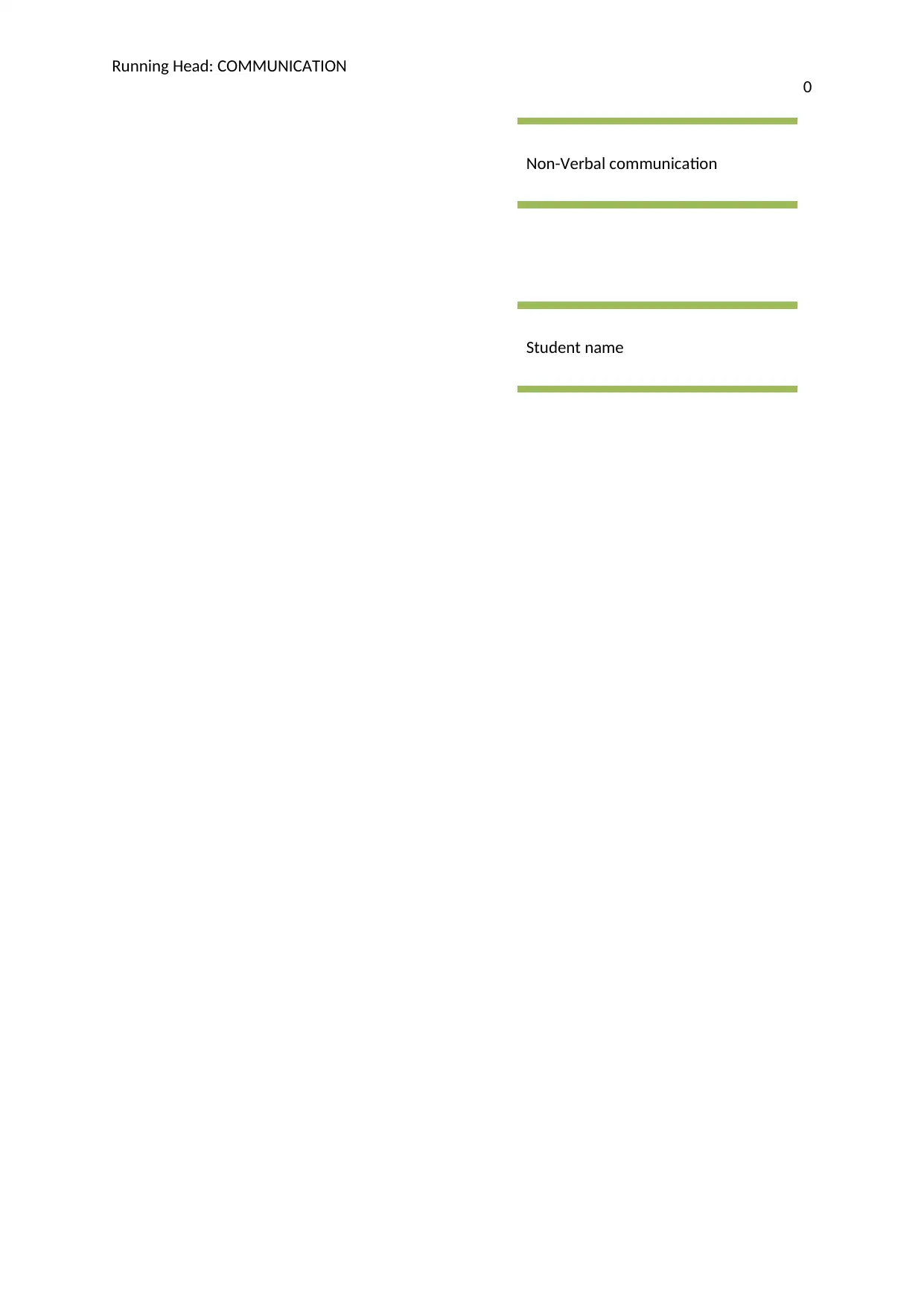
Running Head: COMMUNICATION
0
Non-Verbal communication
Student name
0
Non-Verbal communication
Student name
Secure Best Marks with AI Grader
Need help grading? Try our AI Grader for instant feedback on your assignments.
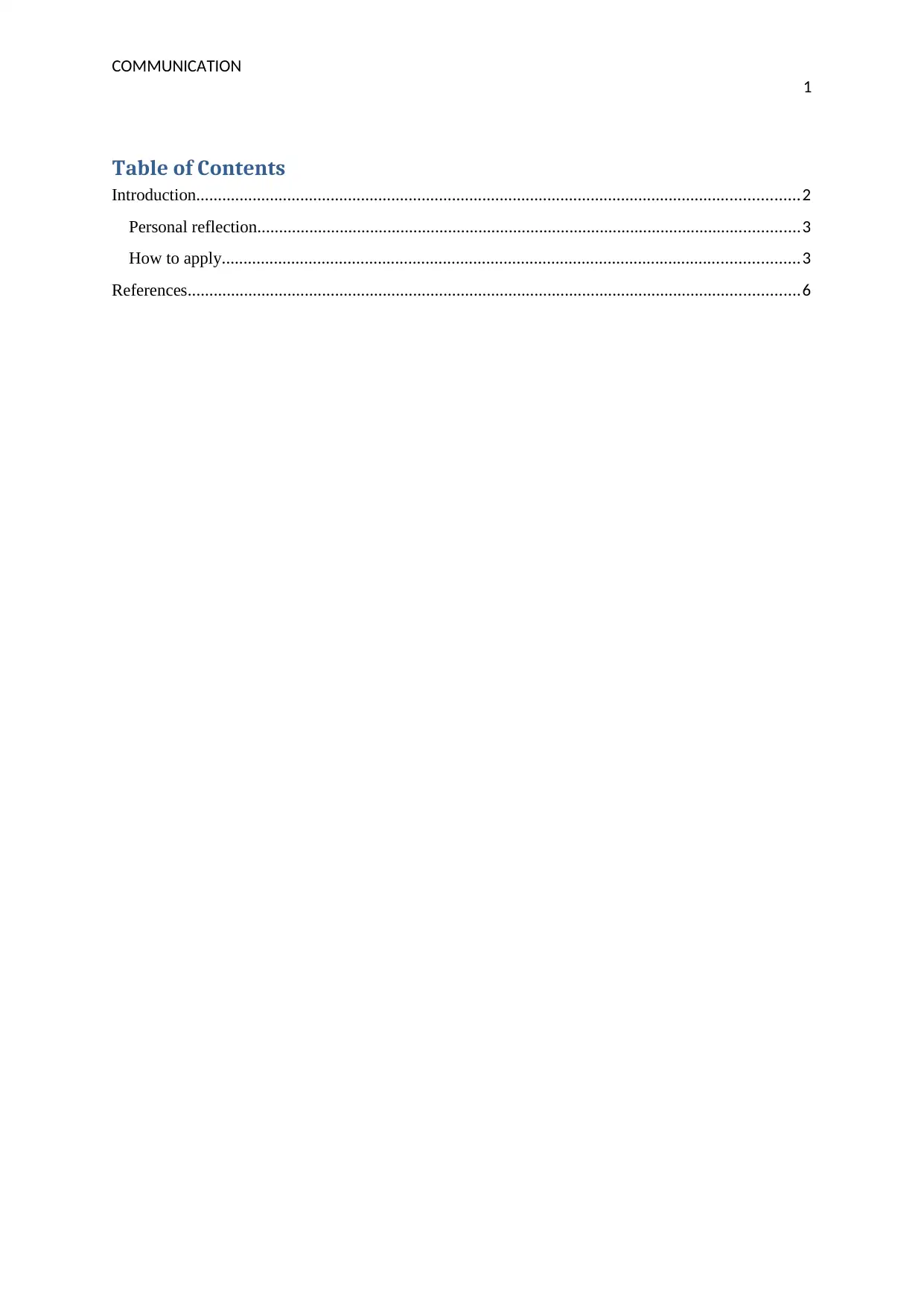
COMMUNICATION
1
Table of Contents
Introduction...........................................................................................................................................2
Personal reflection.............................................................................................................................3
How to apply.....................................................................................................................................3
References.............................................................................................................................................6
1
Table of Contents
Introduction...........................................................................................................................................2
Personal reflection.............................................................................................................................3
How to apply.....................................................................................................................................3
References.............................................................................................................................................6
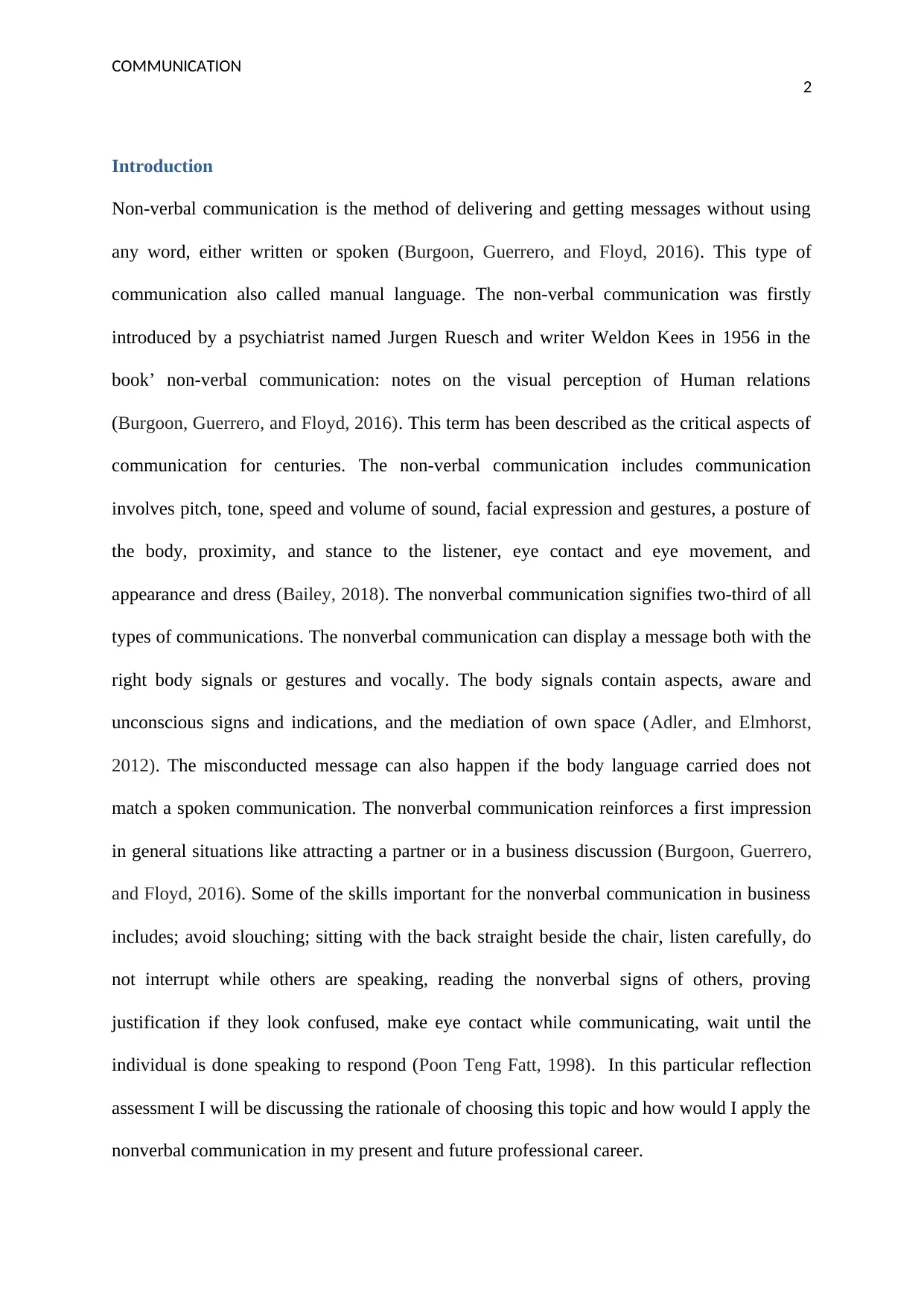
COMMUNICATION
2
Introduction
Non-verbal communication is the method of delivering and getting messages without using
any word, either written or spoken (Burgoon, Guerrero, and Floyd, 2016). This type of
communication also called manual language. The non-verbal communication was firstly
introduced by a psychiatrist named Jurgen Ruesch and writer Weldon Kees in 1956 in the
book’ non-verbal communication: notes on the visual perception of Human relations
(Burgoon, Guerrero, and Floyd, 2016). This term has been described as the critical aspects of
communication for centuries. The non-verbal communication includes communication
involves pitch, tone, speed and volume of sound, facial expression and gestures, a posture of
the body, proximity, and stance to the listener, eye contact and eye movement, and
appearance and dress (Bailey, 2018). The nonverbal communication signifies two-third of all
types of communications. The nonverbal communication can display a message both with the
right body signals or gestures and vocally. The body signals contain aspects, aware and
unconscious signs and indications, and the mediation of own space (Adler, and Elmhorst,
2012). The misconducted message can also happen if the body language carried does not
match a spoken communication. The nonverbal communication reinforces a first impression
in general situations like attracting a partner or in a business discussion (Burgoon, Guerrero,
and Floyd, 2016). Some of the skills important for the nonverbal communication in business
includes; avoid slouching; sitting with the back straight beside the chair, listen carefully, do
not interrupt while others are speaking, reading the nonverbal signs of others, proving
justification if they look confused, make eye contact while communicating, wait until the
individual is done speaking to respond (Poon Teng Fatt, 1998). In this particular reflection
assessment I will be discussing the rationale of choosing this topic and how would I apply the
nonverbal communication in my present and future professional career.
2
Introduction
Non-verbal communication is the method of delivering and getting messages without using
any word, either written or spoken (Burgoon, Guerrero, and Floyd, 2016). This type of
communication also called manual language. The non-verbal communication was firstly
introduced by a psychiatrist named Jurgen Ruesch and writer Weldon Kees in 1956 in the
book’ non-verbal communication: notes on the visual perception of Human relations
(Burgoon, Guerrero, and Floyd, 2016). This term has been described as the critical aspects of
communication for centuries. The non-verbal communication includes communication
involves pitch, tone, speed and volume of sound, facial expression and gestures, a posture of
the body, proximity, and stance to the listener, eye contact and eye movement, and
appearance and dress (Bailey, 2018). The nonverbal communication signifies two-third of all
types of communications. The nonverbal communication can display a message both with the
right body signals or gestures and vocally. The body signals contain aspects, aware and
unconscious signs and indications, and the mediation of own space (Adler, and Elmhorst,
2012). The misconducted message can also happen if the body language carried does not
match a spoken communication. The nonverbal communication reinforces a first impression
in general situations like attracting a partner or in a business discussion (Burgoon, Guerrero,
and Floyd, 2016). Some of the skills important for the nonverbal communication in business
includes; avoid slouching; sitting with the back straight beside the chair, listen carefully, do
not interrupt while others are speaking, reading the nonverbal signs of others, proving
justification if they look confused, make eye contact while communicating, wait until the
individual is done speaking to respond (Poon Teng Fatt, 1998). In this particular reflection
assessment I will be discussing the rationale of choosing this topic and how would I apply the
nonverbal communication in my present and future professional career.
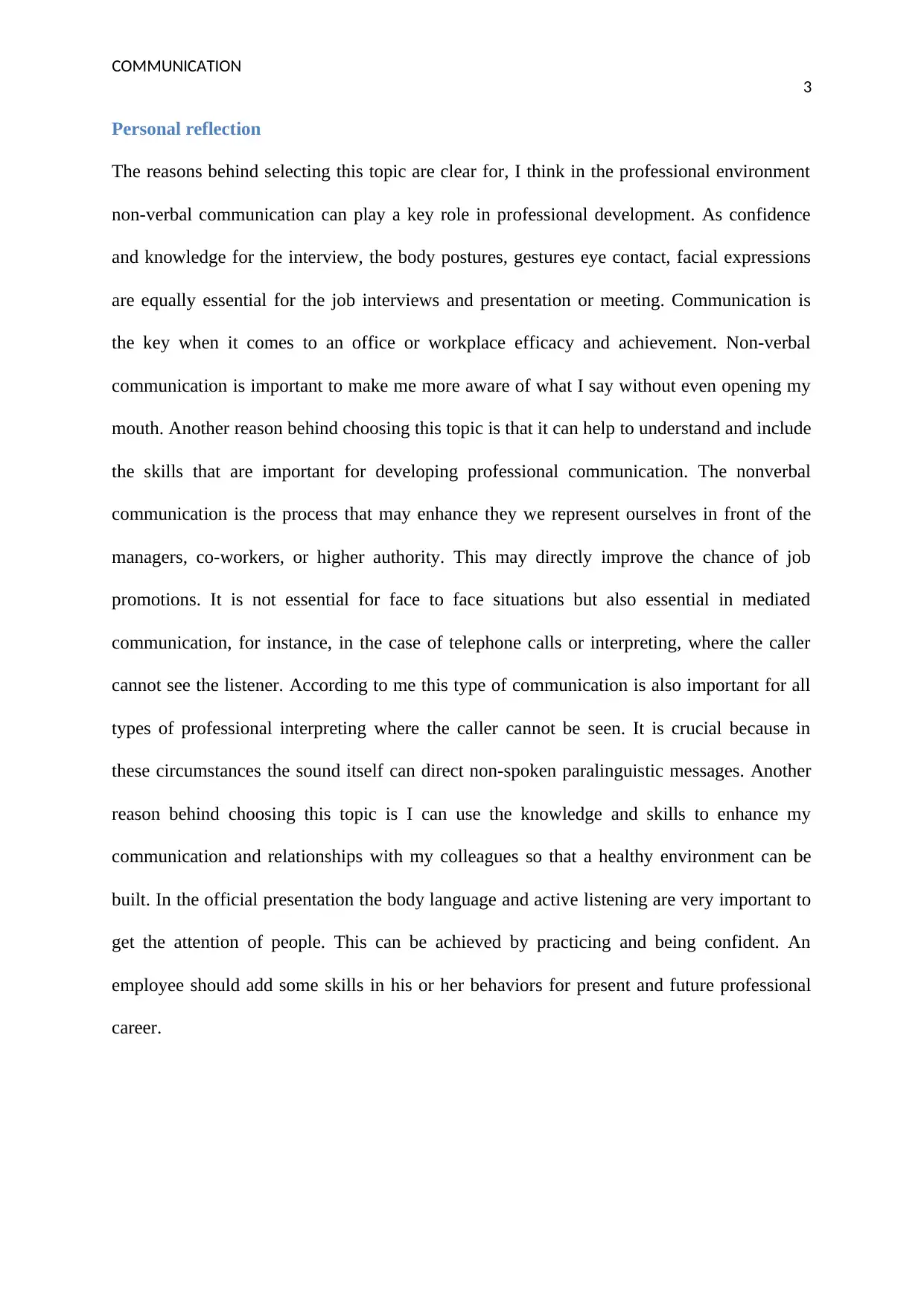
COMMUNICATION
3
Personal reflection
The reasons behind selecting this topic are clear for, I think in the professional environment
non-verbal communication can play a key role in professional development. As confidence
and knowledge for the interview, the body postures, gestures eye contact, facial expressions
are equally essential for the job interviews and presentation or meeting. Communication is
the key when it comes to an office or workplace efficacy and achievement. Non-verbal
communication is important to make me more aware of what I say without even opening my
mouth. Another reason behind choosing this topic is that it can help to understand and include
the skills that are important for developing professional communication. The nonverbal
communication is the process that may enhance they we represent ourselves in front of the
managers, co-workers, or higher authority. This may directly improve the chance of job
promotions. It is not essential for face to face situations but also essential in mediated
communication, for instance, in the case of telephone calls or interpreting, where the caller
cannot see the listener. According to me this type of communication is also important for all
types of professional interpreting where the caller cannot be seen. It is crucial because in
these circumstances the sound itself can direct non-spoken paralinguistic messages. Another
reason behind choosing this topic is I can use the knowledge and skills to enhance my
communication and relationships with my colleagues so that a healthy environment can be
built. In the official presentation the body language and active listening are very important to
get the attention of people. This can be achieved by practicing and being confident. An
employee should add some skills in his or her behaviors for present and future professional
career.
3
Personal reflection
The reasons behind selecting this topic are clear for, I think in the professional environment
non-verbal communication can play a key role in professional development. As confidence
and knowledge for the interview, the body postures, gestures eye contact, facial expressions
are equally essential for the job interviews and presentation or meeting. Communication is
the key when it comes to an office or workplace efficacy and achievement. Non-verbal
communication is important to make me more aware of what I say without even opening my
mouth. Another reason behind choosing this topic is that it can help to understand and include
the skills that are important for developing professional communication. The nonverbal
communication is the process that may enhance they we represent ourselves in front of the
managers, co-workers, or higher authority. This may directly improve the chance of job
promotions. It is not essential for face to face situations but also essential in mediated
communication, for instance, in the case of telephone calls or interpreting, where the caller
cannot see the listener. According to me this type of communication is also important for all
types of professional interpreting where the caller cannot be seen. It is crucial because in
these circumstances the sound itself can direct non-spoken paralinguistic messages. Another
reason behind choosing this topic is I can use the knowledge and skills to enhance my
communication and relationships with my colleagues so that a healthy environment can be
built. In the official presentation the body language and active listening are very important to
get the attention of people. This can be achieved by practicing and being confident. An
employee should add some skills in his or her behaviors for present and future professional
career.
Secure Best Marks with AI Grader
Need help grading? Try our AI Grader for instant feedback on your assignments.

COMMUNICATION
4
How to apply
Applying the nonverbal communicating in the professional life is not that simple as we think.
Nonverbal communication is essential in the job interview. There are some key skills that
should be practiced to apply this type of communication in professional life (Bailey, 2018).
First Impressions
The first some minutes in the interview scenario are very essential that nearly nothing else
matters. The employer sees the job seeker and identifies all of the non-spoken messages he or
she is shared (Bailey, 2018). The employers develop impressions from the applicant’s
posture, handshake, clothing and equipment, space usage, concentration, eye interaction, and
facial expressions. And, then they attend to what he or she has to speak in response to the
questions. Therefore these things should be considered by the job seekers in the interviews
(Bailey, 2018).
Posture and Space Usage
Gestures and postures are equally important as other factors of nonverbal communication. In
a job interview, the employers focus on, is the candidate sitting at ease yet upright, but not
rigidly, in his or her chair? He or she is likely confident and relaxed with herself or himself
(Burgoon, Guerrero, and Manusov, 2011). Slouchy posture says loudly about messy work
and little self-esteem. A posture that allows a person to take up the suitable amount of space
in the interview room tells the employers that the candidate is safe in his capabilities. Messy
posture gives the hollow of low energy and sloppiness (Burgoon, Guerrero, and Manusov,
2011).
Handshake
Shaking hands is another factor that matters in the professional life it tells how confident and
comfortable is the employee in the workplace and how he or she will be communicating with
4
How to apply
Applying the nonverbal communicating in the professional life is not that simple as we think.
Nonverbal communication is essential in the job interview. There are some key skills that
should be practiced to apply this type of communication in professional life (Bailey, 2018).
First Impressions
The first some minutes in the interview scenario are very essential that nearly nothing else
matters. The employer sees the job seeker and identifies all of the non-spoken messages he or
she is shared (Bailey, 2018). The employers develop impressions from the applicant’s
posture, handshake, clothing and equipment, space usage, concentration, eye interaction, and
facial expressions. And, then they attend to what he or she has to speak in response to the
questions. Therefore these things should be considered by the job seekers in the interviews
(Bailey, 2018).
Posture and Space Usage
Gestures and postures are equally important as other factors of nonverbal communication. In
a job interview, the employers focus on, is the candidate sitting at ease yet upright, but not
rigidly, in his or her chair? He or she is likely confident and relaxed with herself or himself
(Burgoon, Guerrero, and Manusov, 2011). Slouchy posture says loudly about messy work
and little self-esteem. A posture that allows a person to take up the suitable amount of space
in the interview room tells the employers that the candidate is safe in his capabilities. Messy
posture gives the hollow of low energy and sloppiness (Burgoon, Guerrero, and Manusov,
2011).
Handshake
Shaking hands is another factor that matters in the professional life it tells how confident and
comfortable is the employee in the workplace and how he or she will be communicating with
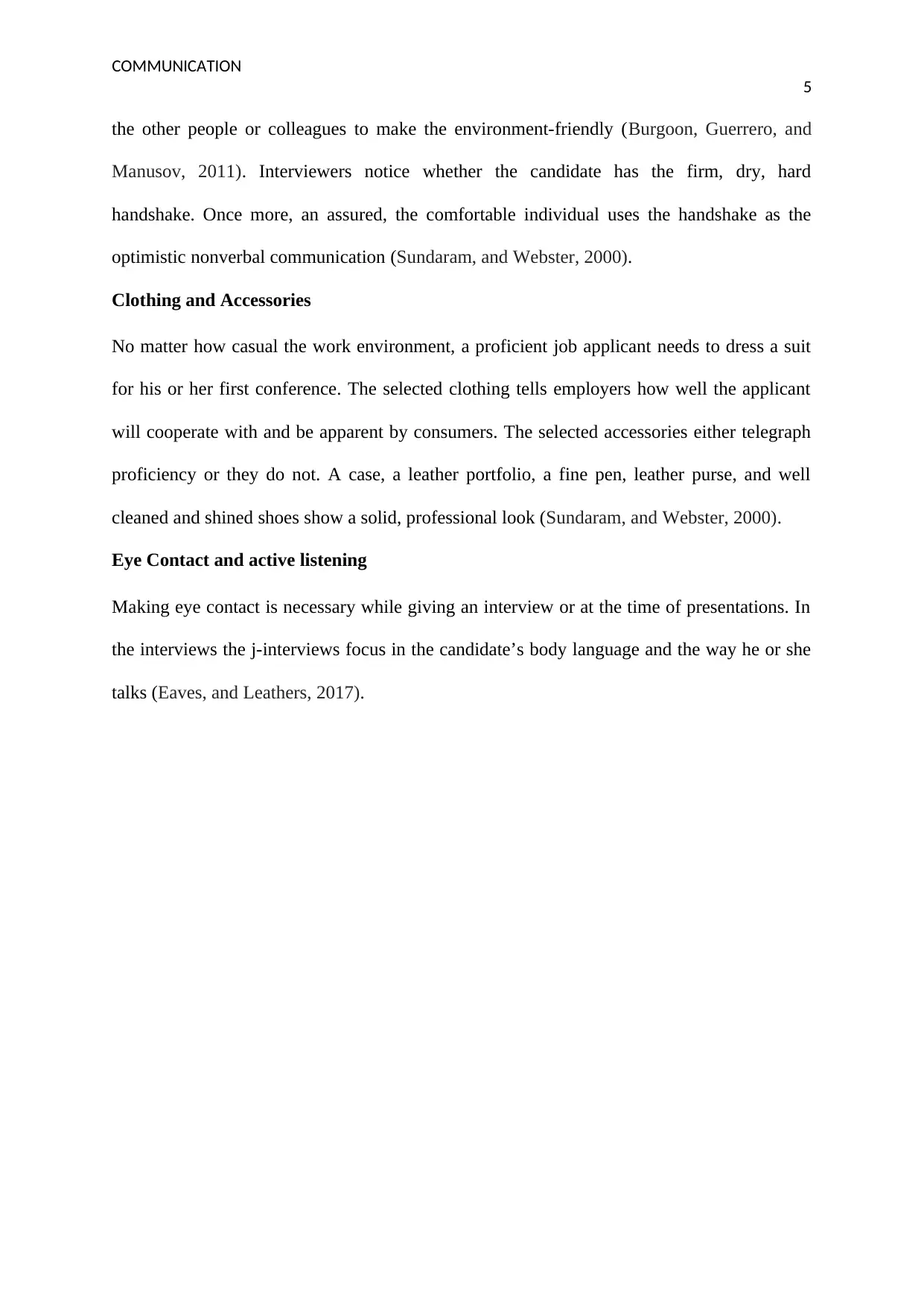
COMMUNICATION
5
the other people or colleagues to make the environment-friendly (Burgoon, Guerrero, and
Manusov, 2011). Interviewers notice whether the candidate has the firm, dry, hard
handshake. Once more, an assured, the comfortable individual uses the handshake as the
optimistic nonverbal communication (Sundaram, and Webster, 2000).
Clothing and Accessories
No matter how casual the work environment, a proficient job applicant needs to dress a suit
for his or her first conference. The selected clothing tells employers how well the applicant
will cooperate with and be apparent by consumers. The selected accessories either telegraph
proficiency or they do not. A case, a leather portfolio, a fine pen, leather purse, and well
cleaned and shined shoes show a solid, professional look (Sundaram, and Webster, 2000).
Eye Contact and active listening
Making eye contact is necessary while giving an interview or at the time of presentations. In
the interviews the j-interviews focus in the candidate’s body language and the way he or she
talks (Eaves, and Leathers, 2017).
5
the other people or colleagues to make the environment-friendly (Burgoon, Guerrero, and
Manusov, 2011). Interviewers notice whether the candidate has the firm, dry, hard
handshake. Once more, an assured, the comfortable individual uses the handshake as the
optimistic nonverbal communication (Sundaram, and Webster, 2000).
Clothing and Accessories
No matter how casual the work environment, a proficient job applicant needs to dress a suit
for his or her first conference. The selected clothing tells employers how well the applicant
will cooperate with and be apparent by consumers. The selected accessories either telegraph
proficiency or they do not. A case, a leather portfolio, a fine pen, leather purse, and well
cleaned and shined shoes show a solid, professional look (Sundaram, and Webster, 2000).
Eye Contact and active listening
Making eye contact is necessary while giving an interview or at the time of presentations. In
the interviews the j-interviews focus in the candidate’s body language and the way he or she
talks (Eaves, and Leathers, 2017).
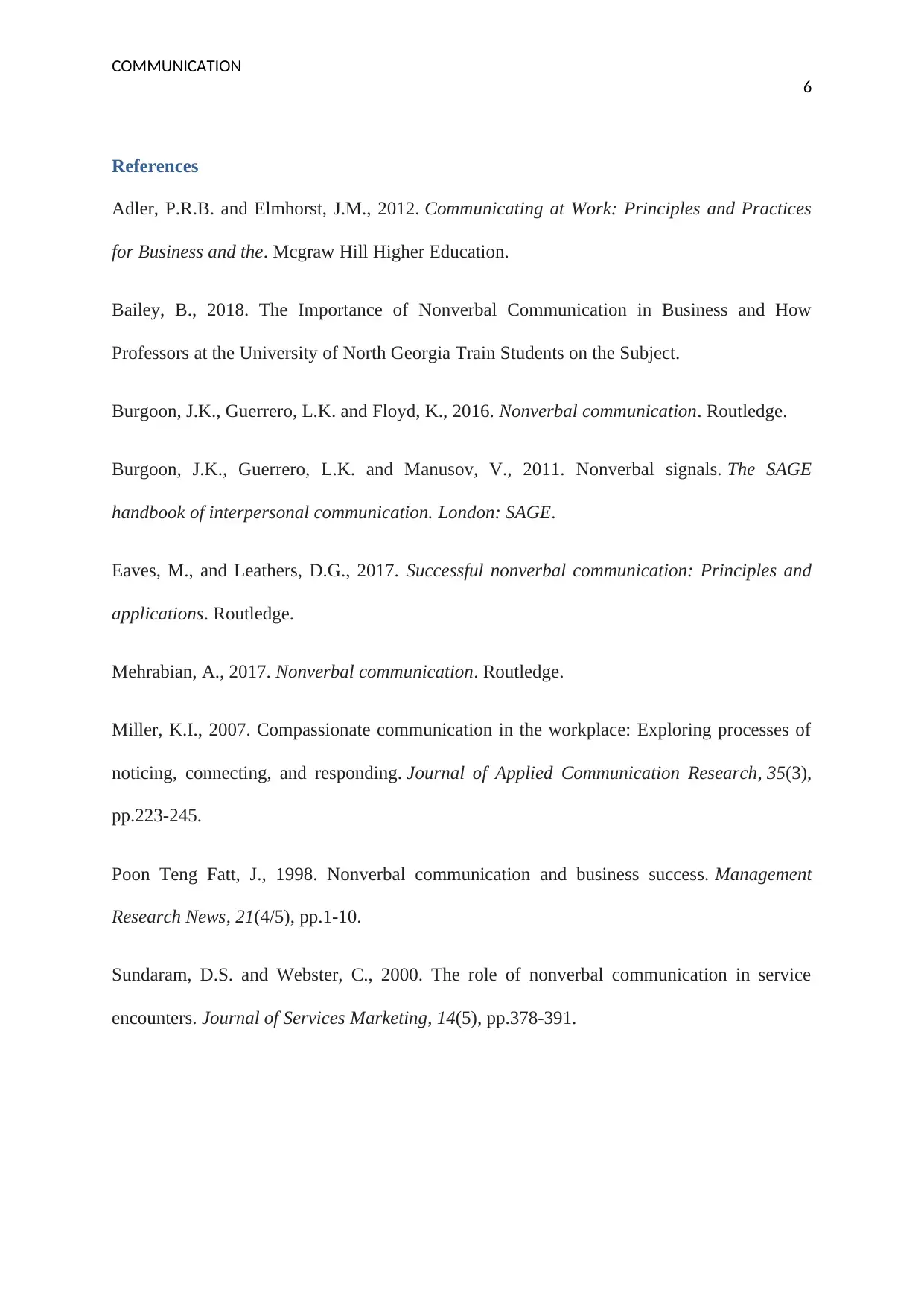
COMMUNICATION
6
References
Adler, P.R.B. and Elmhorst, J.M., 2012. Communicating at Work: Principles and Practices
for Business and the. Mcgraw Hill Higher Education.
Bailey, B., 2018. The Importance of Nonverbal Communication in Business and How
Professors at the University of North Georgia Train Students on the Subject.
Burgoon, J.K., Guerrero, L.K. and Floyd, K., 2016. Nonverbal communication. Routledge.
Burgoon, J.K., Guerrero, L.K. and Manusov, V., 2011. Nonverbal signals. The SAGE
handbook of interpersonal communication. London: SAGE.
Eaves, M., and Leathers, D.G., 2017. Successful nonverbal communication: Principles and
applications. Routledge.
Mehrabian, A., 2017. Nonverbal communication. Routledge.
Miller, K.I., 2007. Compassionate communication in the workplace: Exploring processes of
noticing, connecting, and responding. Journal of Applied Communication Research, 35(3),
pp.223-245.
Poon Teng Fatt, J., 1998. Nonverbal communication and business success. Management
Research News, 21(4/5), pp.1-10.
Sundaram, D.S. and Webster, C., 2000. The role of nonverbal communication in service
encounters. Journal of Services Marketing, 14(5), pp.378-391.
6
References
Adler, P.R.B. and Elmhorst, J.M., 2012. Communicating at Work: Principles and Practices
for Business and the. Mcgraw Hill Higher Education.
Bailey, B., 2018. The Importance of Nonverbal Communication in Business and How
Professors at the University of North Georgia Train Students on the Subject.
Burgoon, J.K., Guerrero, L.K. and Floyd, K., 2016. Nonverbal communication. Routledge.
Burgoon, J.K., Guerrero, L.K. and Manusov, V., 2011. Nonverbal signals. The SAGE
handbook of interpersonal communication. London: SAGE.
Eaves, M., and Leathers, D.G., 2017. Successful nonverbal communication: Principles and
applications. Routledge.
Mehrabian, A., 2017. Nonverbal communication. Routledge.
Miller, K.I., 2007. Compassionate communication in the workplace: Exploring processes of
noticing, connecting, and responding. Journal of Applied Communication Research, 35(3),
pp.223-245.
Poon Teng Fatt, J., 1998. Nonverbal communication and business success. Management
Research News, 21(4/5), pp.1-10.
Sundaram, D.S. and Webster, C., 2000. The role of nonverbal communication in service
encounters. Journal of Services Marketing, 14(5), pp.378-391.
1 out of 7
Related Documents
Your All-in-One AI-Powered Toolkit for Academic Success.
+13062052269
info@desklib.com
Available 24*7 on WhatsApp / Email
![[object Object]](/_next/static/media/star-bottom.7253800d.svg)
Unlock your academic potential
© 2024 | Zucol Services PVT LTD | All rights reserved.





